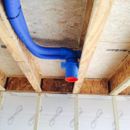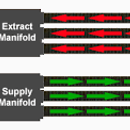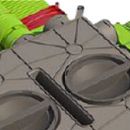Radial semi-rigid ducting
I recently came across a Q&A discussion around Zehnder’s ComfoTube HVAC product that struck me as an interesting concept that could make duct installation much easier (and cheaper if the numbers I’m finding are correct). It took a fair amount of searching to track down other iterations of the same thing, so I thought I would share a few of my findings here and see if anyone has experience with or thoughts about the use of these products in HRV or ducted mini-split installations as a replacement for flexible or sheet metal ductwork.
The product is referred to as radial semi-rigid ducting, radial ducting, or occasionally just semi-rigid ducting. The material is made from high density polyethylene with a ribbed, flexible exterior and a smooth interior. In theory, the polyethylene should avoid the off gassing issues associated with thin wall pvc, the cost/installation issues associated with sheet metal installation, and the airflow/dust issues associated with flexible ductwork. Pipes can be bought in 150+ ft sizes and cut to the exact lengths needed for the duct, eliminating the need for taping/sealing the ducts. Most that I’ve found are in the 2.5″ to 3.5″ range, which means most rooms would need 2 or 3 pipes run to each room. But because the pipes are small and flexible, they can be easily run directly from the vent to the ac unit in a single continuous stretch (often referred to as “home run” ducting). This should reduce the noise transference between rooms through the ductwork (though I’m not sure how big of an issue that would be in a well designed “traditional” ductwork installation). The pipes are then attached on each end using a rubber seal and clip that appears to be easy and straightforward.
In short, they seem to be quite an incredible product.
Now for the downsides I’ve been able to find:
1. The only instance of it’s use in the USA that I can find is by Zehnder in their ComfoTube line. The concept seems to be growing in popularity in the UK in particular and in a few other European countries, but purchasing on this side of the Atlantic would involve either buying from Zehnder or having them shipped overseas. The few instances I’ve found of Zehnder ComfoTube users, however, has been positive so far (https://www.greenbuildingadvisor.com/article/our-top-efficiency-heat-recovery-ventilator).
2. There has been varied acceptance by local building inspectors, so there’s a risk involved to installing radial ducting if you don’t check with the local officials first. Examples of this can be found here (https://www.greenbuildingadvisor.com/question/zehnder-comfotube-code-issue) and here (https://www.greenbuildingadvisor.com/question/does-anyone-have-experience-with-zehnder-comfoflex).
As a reference for anyone else interested in researching the product, here are the vendors I’ve found so far who produce radial semi-rigid ducts (again, all of these, except for Zehnder, do not sell directly to US markets): Domus, Quiet-Vent, EnviroVent, Optiflex, Klimaflex, Flexivent, Airflex (naming theme, anyone?), Titon, Verplas, & HB+.
Places like BPC Ventillation in the UK sell 50m lengths for about $225, which works out to about $1.35/ft. Granted, you’d need to run 2 or 3 per supply/return and pay for shipping, but you can buy the ComfoTube version for about $300 for 162ft, which works out to $1.83/ft. Still a good sight cheaper than sheet metal ducts. And if installation is faster & easier with no chance for leaking in the middle…
So to reach my question, finally, does anyone have thoughts on the use of radial semi-rigid ducting in a new residential home with an HRV and ducted mini-split (beyond the availability & inspector complications)? In particular, I’m thinking that I could use them in a non-Zehnder HRV system to take advantage of the benefits without having to go all in for the expensive unit. Do these seems like a good option from an HVAC perspective and would they offer any performance improvements or detriments? Or any other thoughts on the topic?
GBA Detail Library
A collection of one thousand construction details organized by climate and house part













Replies
I agree with your assessment in regards to HRV/ERV usage. We used and it was fine. The building inspector was a problem, but not in the way we anticipated. He didn't care about the lack of UL rating, he just thought it wasn't sufficient for flow. A design specifying 3" semi rigid duct from a registered HVAC designer satisfied him.
I don't think they would be appropriate for heating / cooling due to higher cfm, but you could run the numbers for a specific design and find out.
Barrett,
1. The code issue is real. No one should use these for ventilation ducting without first making sure that your local code official will approve the use of this type of duct.
2. These are ventilation ducts, not heating ducts. I don't think this type of ductwork is rated for high temperatures associated with heating.
Most HDPE pipes are good up to 60C/140F as an operating temperature. If you can guarantee that the air temps can't get anywhere near 140F the ducts will take the heat, but they're not insulated.
Dettson's much more flexible SmartDuct systemfor their tiny gas furnaces are similarly diminutive in size and are sheathed in some sort of plastic, but I couldn't find a material spec on them.
Metal is the standard industry standard heating duct, and it's not only not insulated, it's almost almost the opposite. The radial tubing is double walled, so there would be a small amount of R-value courtesy the air pockets in the radial ridges. But either way, the HDPE will lose less heat per area than galvanized steel. I'm not sure how much it matters, since that heat "lost" is still within the thermal envelope. I think a bigger concern would be the increased energy cost of the fans pushing higher static pressure into the smaller diameter tubes. I don't know how much CFM a ducted mini split produces, but it's got to be a lot more than a typical HRV.
I just looked at Dettson's website. Their "smart duct" is 2.5" ID, and appears to be just proprietary UL-181 class 1 rated flex duct. Doesn't look like there is any insulation there. The pressure drop in that duct is going to be a lot higher than in a same-sized, smooth walled semi-rigid duct. This is reflected in the 25' length limit they put on it. The installation of such duct, trying to keep it from choking itself off would be a nightmare compared to the installation of the semi rigid duct.
Trevor, thanks for the insight. That will be helpful in approaching our local building inspector!
Martin, thanks for the word of warning. I'll be talking through a number of semi-unusual building details (such as a FSPF) with our building inspector and the use of these ducts will be on the list if we go with them.
I'm advertising my ignorance of the topic here, but Zehnder rates their ducts up to 140 degrees F and it seems like previous discussions around mini-split duct heating temperatures has placed their output lower than that. Could these be used as heating ducts if paired with a ducted mini-split?
Martin,
I didn't mean to imply that the code concerns can be ignored, just that they MAY not be a problem. My advice would be to give a proposal to the building official, specifying the planned materials, then respond to their concerns. Don't ask them about UL-181, as this might put a bug in their ear that wasn't there before. If they bring it up, then you've probably got a problem.